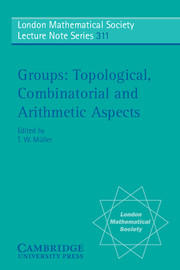Book contents
- Frontmatter
- Contents
- List of authors and participants
- Preface
- 1 Reductive groups as metric spaces
- 2 Finiteness properties of groups acting on twin buildings
- 3 Higher finiteness properties of S-arithmetic groups in the function field case I
- 4 Controlled topology and group actions
- 5 Finiteness properties of soluble S-arithmetic groups – A survey
- 6 Topology in permutation groups
- 7 Euler characteristics of discrete groups
- 8 Intersections of Magnus subgroups of one-relator groups
- 9 A minimality property of certain branch groups
- 10 Lattices with non-integral character
- 11 Some applications of probability in group theory
- 12 Parity patterns in Hecke groups and Fermat primes
- 13 Automorphisms of the binary tree: state-closed subgroups and dynamics of 1/2-endomorphisms
- 14 The mapping class group of the twice punctured torus
- 15 Kac–Moody groups: split and relative theories. Lattices
- 16 On the finite images of infinite groups
- 17 Pseudo-finite generalized triangle groups
15 - Kac–Moody groups: split and relative theories. Lattices
Published online by Cambridge University Press: 04 November 2009
- Frontmatter
- Contents
- List of authors and participants
- Preface
- 1 Reductive groups as metric spaces
- 2 Finiteness properties of groups acting on twin buildings
- 3 Higher finiteness properties of S-arithmetic groups in the function field case I
- 4 Controlled topology and group actions
- 5 Finiteness properties of soluble S-arithmetic groups – A survey
- 6 Topology in permutation groups
- 7 Euler characteristics of discrete groups
- 8 Intersections of Magnus subgroups of one-relator groups
- 9 A minimality property of certain branch groups
- 10 Lattices with non-integral character
- 11 Some applications of probability in group theory
- 12 Parity patterns in Hecke groups and Fermat primes
- 13 Automorphisms of the binary tree: state-closed subgroups and dynamics of 1/2-endomorphisms
- 14 The mapping class group of the twice punctured torus
- 15 Kac–Moody groups: split and relative theories. Lattices
- 16 On the finite images of infinite groups
- 17 Pseudo-finite generalized triangle groups
Summary
Introduction
Historical sketch of Kac–Moody theory.— Kac-Moody theory was initiated in 1968, when V. Kac and R. Moody independently defined infinite-dimensional Lie algebras generalizing complex semi-simple Lie algebras. Their definition is based on Serre's presentation theorem describing explicitly the latter (finite-dimensional) Lie algebras [Hu1, 18.3]. A natural question then is to integrate Kac–Moody Lie algebras as Lie groups integrate real Lie algebras, but this time in the infinite-dimensional setting. This difficult problem led to several propositions. In characteristic 0, a satisfactory approach consists in seeing them as subgroups in the automorphisms of the corresponding Lie algebras [KP1,2,3]. Thisway, V. Kac and D. Peterson developed the structure theory of Kac–Moody algebras in complete analogy with the classical theory: intrinsic definition and conjugacy results for Borel (resp. Cartan) subgroups, root decomposition with abstract description of the root system… Another aspect of this work is the construction of generalized Schubert varieties. These algebraic varieties enabled O. Mathieu to get a complete generalization of the character formula in the Kac–Moody framework [Mat1]. To this end, O. Mathieu defined Kac–Moody groups over arbitrary fields in the formalism of ind-schemes [Mat2].
Combinatorial approach. — Although the objects above – Kac–Moody groups and Schubert varieties – can be studied in a nice algebro-geometric context, we will work with groups arising from another, more combinatorial viewpoint. All of this work is due to J. Tits [T4,5,6,7], who of course contributed also to the previous problems.
- Type
- Chapter
- Information
- GroupsTopological, Combinatorial and Arithmetic Aspects, pp. 487 - 541Publisher: Cambridge University PressPrint publication year: 2004



